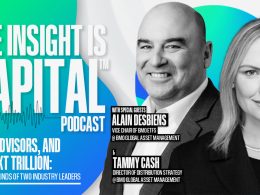by Ben Carlson, A Wealth of Common Sense
In The Success Equation, Michael Mauboussin tells the story of a man in the 1970s who set out to find a lottery ticket ending with the number 48. He bought the ticket he was looking for and ended up winning the lottery using his lucky numbers. When the man was asked why he wanted that specific number on his ticket he replied, “I dreamed of the number 7 for seven straight nights. And 7 times 7 is 48.”
I guess, at times, it’s better to be lucky than good.
I was reminded of this story yesterday while I was having a discussion about the possibility for much lower than average stock and bond returns over the next decade. I said if this happens it would actually be a positive development for those who are planning on being net savers over the coming years because lower returns have typically been accompanied by increased levels of volatility. This would give investors who dollar cost average into the markets plenty of opportunities to buy at lower prices.
The counter-argument I received was that the sequence of returns can matter a great deal in these scenarios. If the final year happens to fall during a market crash or a roaring bull market, it can create drastic differences in the ending balance. After some back and forth my conclusion was that, unfortunately, sometimes luck plays a larger role in our investment performance that many are willing to admit.
For example, I took a look at all 30 year annual periods going back to 1928 using a simple 75/25 U.S. stock/bond portfolio. There have been 58 such instances in all through the end of 2014. For each I assumed that an individual decided to start out saving $5,500 per year, increasing that amount annually by 3% to account for inflation. So every period has the same exact portfolio with the same amount saved (I’m ignoring the time value of money over the different time frames because I’m more concerned with the effects from the sequence of returns than anything).
How much do the returns streams matter over time when it comes to the ending balance after 30 years? It turns out they can matter a great deal as the range in ending balances was huge and highly dependent on the time period selected to start saving money.
For example, the best scenario turned out to be someone who started out investing in 1970 and finished saving in 1999. This was the perfect 30 year period because the 1970s were a difficult, volatile decade for financial market returns, so you would have been buying up shares at lower prices, most notably during the 1973-74 bear market, at the outset. And the period ended at the peak in one of the greatest bull markets of all-time. The ending balance in this scenario was nearly $2.9 million (these numbers are gross of all fees and expenses so take them with a grain of salt).
On the other hand, the worst period started in 1945 and ended in 1974 at the bottom of that nasty bear market in the mid-1970s. The ending balanced was just $774,000 or nearly $2.1 million lower than the 1999 end date. The crazy thing about these results is that the returns weren’t that bad in the worst period. From 1970-1999, the annual returns on this 75/25 portfolio were very good — 12.5% per year. In the 1945-1974 time frame the returns were a very respectable 8.6% annually. That’s a great return over three decades, but the low end point penalized the results.
The hypothetical investor in each of these scenarios did everything they could to ensure a successful outcome, including an annual rebalance. One just happened to get lucky while the other didn’t. A few takeaways from this example and my discussion:
- Relying exclusively on investment returns to power your portfolio is very risky. Saving more and earning more money can help reduce this risk.
- Having a flexible long-term financial plan is key. The example provided here is fairly static and we all know that real life is much more dynamic. Nothing is ever set in stone, so any time you’re looking out over a very long time horizon you’ll be making estimates with a very low degree of precision. That’s just the way these things work. It’s best to make updates and corrections over time, as needed.
- It’s worth remembering that your portfolio doesn’t have a start or an end date, nor does your risk tolerance stay the same throughout your lifetime. In the 30 year time horizon with the best ending balance, the end date was just before stocks got cut in half over the ensuing two and a half years. People don’t stop investing the day they retire as most have many more decades ahead of them. The results of the worst case scenario that ended in 1974 would have been dramatically improved by a few year’s worth of patience. Real life performance is never quite the same thing as you’ll see on a spreadsheet or simulation.
- Saving money over time in the financial markets can yield exceptional results. The average ending balance for all the 30 year periods I looked at was over $1.4 million (again, no fees or distributions taken). The actual amount saved in this example was only $261,000. Compound interest is a wonderful asset that not enough people take advantage of.
Further Reading:
Things People in the Finance Industry Don’t Want You to Know
Rooting For a Bear Market?
Copyright © A Wealth of Common Sense















